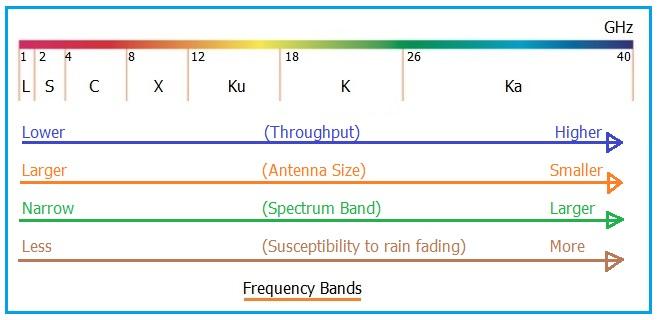C Band Frequency: Values, Advantages, and Applications
Advertisement
This article explores the characteristics of the C band frequency, including its values, advantages, and common applications.
C Band Frequency Values
The C band sits between the S and X bands in the electromagnetic spectrum. Here’s a breakdown of its key frequency and wavelength ranges:
| Frequency Band Designation | Frequency Range | Wavelength |
|---|---|---|
| Generic C Band | 4 to 8 GHz | 7.5 to 3.8 cm |
| Extended C Band (Transmit) | 5.85 GHz to 6.425 GHz | - |
| Extended C Band (Receive) | 3.625 GHz to 4.2 GHz | - |
| Super Extended C Band (Transmit) | 5.85 GHz to 6.725 GHz | - |
| Super Extended C Band (Receive) | 3.4 GHz to 4.2 GHz | - |
As shown in the table above and the figure below, the C band generally spans from 4 GHz to 8 GHz, corresponding to wavelengths of 3.8 to 7.5 centimeters.

Advantages of C Band Frequency
Compared to other frequency bands, the C band offers several benefits:
- Reduced Rain Fade: It experiences less interference from heavy rain, making it more reliable in various weather conditions.
- Cost-Effective Bandwidth: The bandwidth is typically cheaper compared to other bands.
- Mature VSAT Technology: It’s been widely used for VSAT (Very Small Aperture Terminal) applications for many years, leading to easier installation and management of C Band VSAT networks. Numerous satellites (e.g., Intelsat, INSAT, AsiaSat, Galaxy) support C band communication.
C Band Frequency Applications
Here are some common applications of the C band frequency:

- Satellite Communication: Primarily used for communication between ground stations and satellites. Uplink frequencies (ground station to satellite) typically range from 5.925 to 6.425 GHz, while downlink frequencies (satellite to ground station) range from 3.7 to 4.2 GHz.
- Weather Radar Systems: Utilized in weather radar to detect and track precipitation.
- Terrestrial Microwave Links: Used for point-to-point communication over land.
- 802.11a WiFi: An early version of WiFi utilized the C band.
Advertisement
 RF
RF



